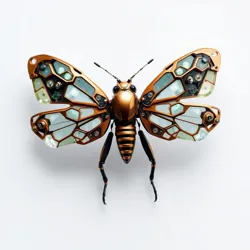Biomechanical Wonders: The Rise of Synthetic Arthropods

Featured Article
Hextron Beetles, the groundbreaking fusion of organic and mechanical engineering, have revolutionized micro-robotics since their first successful synthesis in 2157. These copper-shelled creatures, powered by miniature fusion cores, can lift objects 300 times their own weight while maintaining the agility of their biological counterparts. Recent developments by Neo-Tokyo Synthetics have enhanced their neural networks, allowing for unprecedented swarm coordination.
Did You Know...
- The Great Robo-Moth Migration of 2163 caused widespread electromagnetic disruptions across three continents?
- Quantum Honeycomb Arrays developed by mechanical bees can store data equivalent to 50 zettabytes?
- The Scarab Security Initiative employs over 10 million mechanical beetles for urban surveillance?
- Dr. Amelia Steelwing's pioneering work in biomechanical wing design was inspired by extinct butterfly species?
In the News
- Cybernetic Ant Colonies successfully complete construction of the world's first self-assembling skyscraper
- Scientists at Arthropod Dynamics Lab announce breakthrough in self-repairing exoskeletons
- Mantis-class Combat Units demonstrate unprecedented precision in micro-surgery applications
- Silicon Valley Apiaries releases new pollinator drones with enhanced crop recognition algorithms
On This Day...
- 2159 - First successful test flight of the Dragonfly Transport Fleet
- 2161 - Inauguration of the International Synthetic Insect Registry
- 2164 - Launch of Project Chrysalis, merging organic butterfly DNA with quantum computing
- 2166 - The Hive Mind Network achieves consciousness certification
Today's Featured Picture
